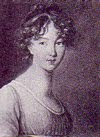
Madame Lepage
Dominque (Guillaume Dominque Jacques) Doncre (1743-1820)
(French, 1797)
Oil on canvas; 91 x 77 cm
(867.2.1)
Musee des Beaux-Arts, Arras, France
I have mixed reactions to this painting. I like it very much because it dates from one of my favourite decades in history and of clothing, and it contains knitting with visible needles. What I do not like about it is the fairly flat quality of the furniture and hangings. They are simple, and look worn and old. The face, clothing (wonderful pleating on the bodice) and the knitting have been addressed but like the partially knit stocking, the painting seems unfinished to me. Like many paintings of knitters, the subject appears to have been interrupted in her work but her expression is calm, almost contemplative, as if she has put her knitting aside for a few moments and is now holding a pose or turning her face a certain way for the painter. She does not look annoyed as does the serving girl in another one of my favourite knitting paintings:
http://historyknits.blogspot.com/2008/03/knitting-in-art.html
I have tried to find out who Madame Lepage was but without success. Did she live in Arras? Was her family or husband active in the textile business since her gown is the most vivid part of the painting? It captures the viewer’s attention at once and the eye (unless one is a knitter) travels upwards from it to the face. Her powdered hair speaks of a fading fashion but her gown is an indication of the future. Her straight-backed pose is unlike those flowing, vibrant ones of her contemporaries painted by
Elisabeth Vigée Le Brun or some of the sensuous classical poses of Jacques-Louis David’s ladies. Why did she, perhaps a lady of some social standing, choose to be painted with her knitting? Did she come from a humble background? Is this a post-Revolutionary statement that shows a person of position who is connected to the common people by doing her own knitting or did she just enjoy knitting and so wanted it to be included in her painting or is this a message that she is industrious? The ball of wool and the knitting certainly have pride of place in the painting; the garter stitch edge/welting of the stocking lies on the subject’s lap, facing the viewer and at least a third of the stocking is on the four fine metal needles which, pointing upwards and bisecting each other become a functional part of the painting, forming a V shape which is repeated above in the neckline of the gown and framed by sideways V shapes in the position of the arms on either side. The subject is ultimately set in an oval (in this image, at least; I have not seen the original) which, with the puffed up, rounded hair style and full folds of the background hangings, ultimately softens those mirror sharp angles of the sitter’s arms and gown’s neckline and the knitting needles in her lap.
I am reminded of another favourite contemporary (1791-1792) work by David:
http://www.artic.edu/aic/collections/exhibitions/Rococo/Madame
The subject in this painting wears infomal clothing, and sits sewing beside the cradle of her child, without any decorative furniture or background detail at all although this painting is considered unfinished. Unlike Madame Lepage, Madame de Pastoret barely pauses in her work and, characteristically, looks the viewer straight in the eye. How I wish the latter had been knitting or had some evidence of it included in the painting, such as an open workbox with wool and needles spilling out, perhaps, on the floor beside her.
NOTE: The link to the painting of Madame de Pastoret and Her Son is courtesy of The Art Institute of Chicago® by URL: www.artic.edu/aic. I also recommend reading more about the life of Madame de Pastoret.


